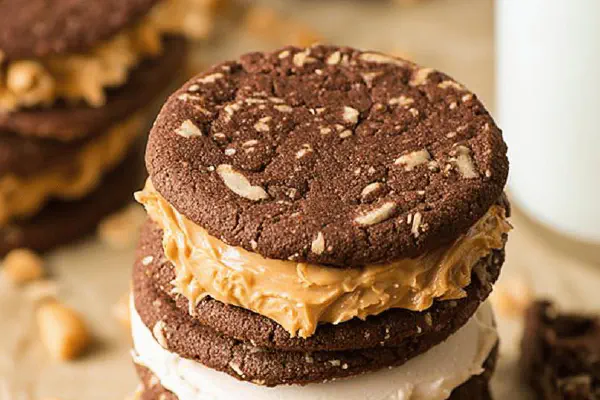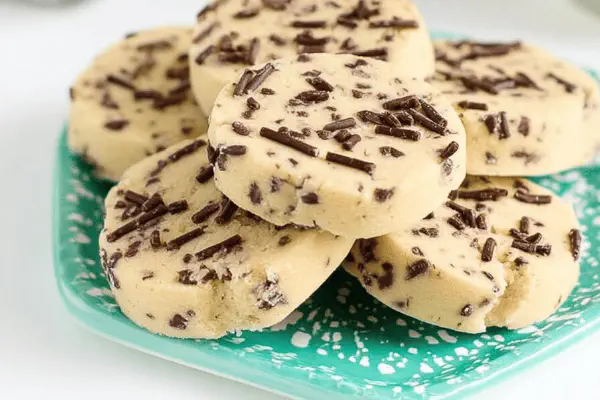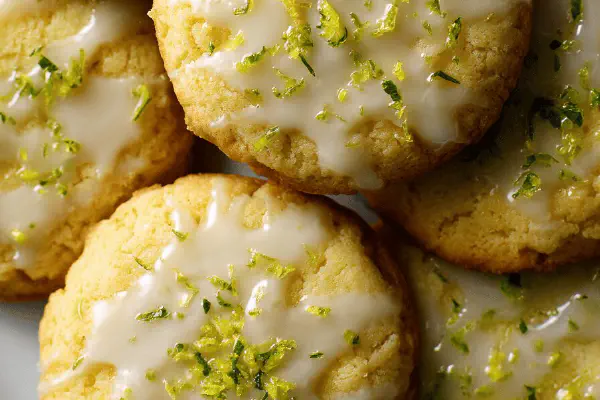Vanilla Almond Shortbread

By Emma
Certified Culinary Professional
Ingredients
- 155 g (1 1/4 cups) all-purpose flour
- 70 g (1/2 cup) almond flour
- 5 ml (1 teaspoon) baking soda
- 1 ml (1/4 teaspoon) fine sea salt
- 1 large egg
- 1 large egg yolk
- 130 g (2/3 cup) sugar
- 8 ml (1 1/2 teaspoons) pure vanilla extract
- 110 g (1/2 cup) unsalted butter, softened
- Fingerprint of ground cardamom (optional)
- Coarse sanding sugar for dusting
Egg Wash
- 1 large egg yolk
- 15 ml (1 tablespoon) heavy cream
About the ingredients
Method
Dough Prep
- In a bowl, sift together all-purpose flour, almond flour, baking soda, salt, and cardamom if using. Mix dry well to distribute.
- In a separate large mixing bowl, whisk the egg, yolk, sugar, and vanilla with an electric mixer or vigorous hand whisk until pale and slightly thickened — don’t overbeat. Soft butter chunks slip in next. Blend until combined but avoid warming the butter too much.
- Add dry ingredients gradually; fold gently with a spatula to a consistent dough. Resist temptation to knead — want tender crumb, not tough chew.
- Press into a flat disc, wrap snugly with plastic wrap. Refrigerate minimum 45 minutes. Chilling firms butter, arrests spread in oven, and develops flavor.
Baking Setup
- Heat oven to 175 C (350 F). Center rack placement critical. Line two baking trays with parchment to catch buttery drips and any spreading. Dust a work surface lightly with flour.
Rolling and Shaping
- Roll dough out to about 6 mm thickness — thinner fragile, thicker chewy. Use a 7.5 cm (3 inch) fluted cookie cutter. Reroll scraps once — overworking dries dough.
- Arrange cookies spaced generously on trays. Press lemon sanding sugar or coarse sugar atop each for crunch and sparkle. Eggs and sugar create gloss and color through Maillard reaction.
Egg wash
- Brush cookies lightly with egg yolk plus cream mix. Cream fattens, deepens color, and adds sheen over milk, which thins paint and dulls finish.
Bake
- Pop trays in separately — one can cool while other bakes. Target 18–22 minutes but watch edges. When edges blush golden brown yet centers remain pale and set — firm to touch but not hard — ready. Oven varies, so jiggle cookie gently; if it cracks, done. Smell rich vanilla and butter, a slight caramelization.
- Remove on spatula onto wire rack immediately. Crispness evolves as cookies cool — warm equals delicate, cooling yields snap.
- Store airtight after fully cool, or freeze dough discs ahead to bake fresh luxury later.
Cooking tips
Chef's notes
- 💡 Eggs and sugar whipped till pale thin layer air pockets. Helps crumb lightness but stop just shy of mousse; overbeat breaks texture. Butter chunks folded in cold, not melted or too soft or oils separate. Timing butter temp by touch critical; firm yet pliable.
- 💡 Dough chilling mandatory; firms fats and starches lock. Rest minimum 45 minutes, longer makes dough less sticky but risks drying if uncovered. Wrapped tightly in plastic stops fridge odors seeping in. Shape dough cold or it’s greasy mess. Re-roll scraps only once after rest, too much folding works gluten tough.
- 💡 Baking tray lined loosely parchment, not wax paper or foil, lets heat distribute well. Oven temp 175 C not 180 or edges burn fast. Placement center rack best for even heat and color. Track visually for amber edges and matte centers. Flick cookie gently; cracks present means cooked through. Smell cues vanilla and caramelize butter must signal end.
- 💡 Egg wash blend egg yolk with cream, no milk. Milk thins, dulls gloss and color. Cream fattens and deepens surface sheen with Maillard reaction. Brush sparingly or sugars lose crunch. Apply right before bake—too early softens sugar crystals. Cream lasts longer under intense oven heat.
- 💡 If almond flour unavailable, partial oat flour with cornstarch works but expect dense crumb and less moist. Coconut sugar can swap refined sugars for earthy tone but shifts color darker. Cardamom optional; skip if no interest but adds complex nutty spice. Dough mix done in small batches when kitchen warm keeps butter from melting and dough sticky which ruins texture.
Common questions
Why use baking soda instead of baking powder?
Baking soda offers subtle lift without metallic or bitter aftertaste. Needs acidic balance sometimes, here egg yolk acidity sufficient. Gives crumb airy but stays crumbly, avoids puffiness typical of powders. Small doses only; too much reaction spoils taste.
How thick should I roll dough?
About 6 mm, thinner means fragile cookies prone to break. Thicker yields chewier texture but can underbake center. Watch visually edges for color cues over timing alone. Use fluted cutter 7.5 cm for uniform baking. Keep flour light on surface, excess dries dough fast.
What if cookies spread too much during baking?
Chill dough longer, butter warmens structure. Overworked gluten or too soft butter causes spread. Check fridge temp, maybe chill trays too. Use parchment, not greased pans; grease encourages spread. Flatten dough gently; pressing too hard compresses fats enabling melt faster in oven.
How to store cookies and dough?
Store fully cool cookies airtight room temp or fridge; humidity makes soft. Freeze baked cookies a week max, re-crisp in low oven before eating. Dough discs wrap plastic tight, freeze months. Thaw in fridge before cutting. No double freeze. Cookie freshness linked to airtight storage.



